In this week’s parasha, Noach, we read about the Great Flood, when “all the fountains of the great deep split apart, and the floodgates of the skies opened” (Genesis 7:11). While it is easy to understand the rain that fell upon the Earth “for forty days and forty nights”, what is the Torah referring to when it speaks of the waters of the deep? Why does it say that the “great deep” had to be “split apart” (נִבְקְעוּ֙) to bring forth these waters? And the biggest mystery of all: how was there even enough water to cover the entire Earth with water anyway, up to the tallest mountains? Upon closer examination, we find that these mysterious waters of the deep actually hold the key to solving the entire mystery of the Flood.
Kola Superdeep Borehole
In May of 1970, Soviet scientists began drilling into the Earth’s crust in the far north of the Kola Peninsula between Norway and Russia. Their goal was to dig the deepest hole ever, and uncover what is really happening in the Earth’s innards. Nine years later, they broke the world record for depth, reaching almost 10 kilometres underground. They hit the deepest point in 1989, reaching 12,262 metres. Beyond this, they could no longer continue, for the temperature was much higher than expected (over 180ºC) and the rock became far too porous.

 Along the way, the scientists found some bizarre things. One was small fossilized lifeforms more than 6 kilometres down, where lifeforms should not—and should never—have existed! Another shocking discovery was that the porous rock deep below was completely saturated with water. More recently, scientists from Northwestern University examined rocks from the mantle (which emerged from volcanoes) and found that they were composed of 1.5% water. After further research, they concluded that there is three times more water beneath the Earth’s crust than there are in all of the world’s oceans! The temperature down there is very high, but so is the pressure, keeping the water liquid and squeezing it out of the porous rocks. With this in mind, we can solve a number of great mysteries.
Along the way, the scientists found some bizarre things. One was small fossilized lifeforms more than 6 kilometres down, where lifeforms should not—and should never—have existed! Another shocking discovery was that the porous rock deep below was completely saturated with water. More recently, scientists from Northwestern University examined rocks from the mantle (which emerged from volcanoes) and found that they were composed of 1.5% water. After further research, they concluded that there is three times more water beneath the Earth’s crust than there are in all of the world’s oceans! The temperature down there is very high, but so is the pressure, keeping the water liquid and squeezing it out of the porous rocks. With this in mind, we can solve a number of great mysteries.
First, we now have a scientific source for where much of the water for the Flood came from. Rain clouds alone would not have been enough. Note how the Torah mentions the waters of the great deep first, before mentioning the rain, implying that the former was the more significant source of water. Second, we can better understand the Torah’s precise language, since it says the depths had to be “split apart” for the floodwaters to emerge. This splitting apart would certainly be required for all that water in the mantle beneath to emerge. Third, we can actually solve a scientific mystery for the baffled scientists at Kola who found fossilized ancient lifeforms deep below: Perhaps those lifeforms ended up there when the floodwaters returned underground and the surface closed back up, sealing lifeforms from above down beneath in a place where they otherwise could never have gotten.
There is one more wonderful confirmation of all this when we look at the way our Sages described the Flood: the Talmud (Sanhedrin 108b) states that the floodwaters that came from below, “between their legs”, was boiling hot! This was measure for measure justice from God, since the people “sinned with heat, so they were punished with heat”. Heat here is a euphemism for sexual sin, and since the pre-Flood generation abused their nether regions, “between their legs”, God made sure that those floodwaters that came from below were boiling hot. Recall that the scientists at Kola were surprised that the temperature below was much hotter than they expected (yet the water remained in liquid form). They had to stop drilling because the rock was too mushy and “like plastic”. It is worth adding that the same page of Talmud says the water from below was not only hot, but also thick.
“Setting the Earth Upon the Waters”
There is one more fascinating mystery that can be solved with the scientific discovery of the Earth’s inner waters. Each morning, in Birkot HaShachar, we thank God for “setting the earth upon the waters” (רוקַע הָאָרֶץ עַל הַמָּיִם). This blessing troubled me for years. What does it mean that the earth is set upon the waters? Earth’s crust is set upon the rocky mantle, lying above the molten core—and the waters are resting upon the crust! It all seemed backwards. Yet, now we can see, as is often the case, that the Sages phrased it correctly all along: the crust is resting upon a mantle that is full of water, three times more water than in all the oceans! With that, we can appreciate this berakhah much more deeply, and recite it with ever-more kavanah.

